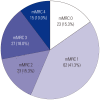Dyspnea as a Prognostic Factor in Patients with Non-Small Cell Lung Cancer
- PMID: 27401635
- PMCID: PMC4960370
- DOI: 10.3349/ymj.2016.57.5.1063
Dyspnea as a Prognostic Factor in Patients with Non-Small Cell Lung Cancer
Abstract
Purpose: To investigate associations between dyspnea and clinical outcomes in patients with non-small cell lung cancer (NSCLC).
Materials and methods: From 2001 to 2014, we retrospectively reviewed the prospective lung cancer database of St. Paul's Hospital at the Catholic University of Korea. We enrolled patients with NSCLC and evaluated symptoms of dyspnea using modified Medical Research Council (mMRC) scores. Also, we estimated pulmonary functions and analyzed survival data.
Results: In total, 457 NSCLC patients were enrolled, and 259 (56.7%) had dyspnea. Among those with dyspnea and whose mMRC scores were available (109 patients had no mMRC score), 85 (56.6%) patients had an mMRC score <2, while 65 (43.3%) had an mMRC score ≥2. Significant decreased pulmonary functions were observed in patients with dyspnea. In multivariate analysis, aging, poor performance status, advanced stage, low forced expiratory volume in 1 second (%), and an mMRC score ≥2 were found to be significant prognostic factors for patient survival.
Conclusion: Dyspnea could be a significant prognostic factor in patients with NSCLC.
Keywords: Lung neoplasm; dyspnea; prognosis.
Conflict of interest statement
The authors have no financial conflicts of interest.
Figures



References
-
- Jemal A, Bray F, Center MM, Ferlay J, Ward E, Forman D. Global cancer statistics. CA Cancer J Clin. 2011;61:69–90. - PubMed
-
- Luengo-Fernandez R, Leal J, Gray A, Sullivan R. Economic burden of cancer across the European Union: a population-based cost analysis. Lancet Oncol. 2013;14:1165–1174. - PubMed
-
- Walters S, Maringe C, Coleman MP, Peake MD, Butler J, Young N, et al. Lung cancer survival and stage at diagnosis in Australia, Canada, Denmark, Norway, Sweden and the UK: a population-based study, 2004-2007. Thorax. 2013;68:551–564. - PubMed
-
- Carlson LE, Waller A, Groff SL, Bultz BD. Screening for distress, the sixth vital sign, in lung cancer patients: effects on pain, fatigue, and common problems--secondary outcomes of a randomized controlled trial. Psychooncology. 2013;22:1880–1888. - PubMed
MeSH terms
LinkOut - more resources
Full Text Sources
Other Literature Sources
Medical

